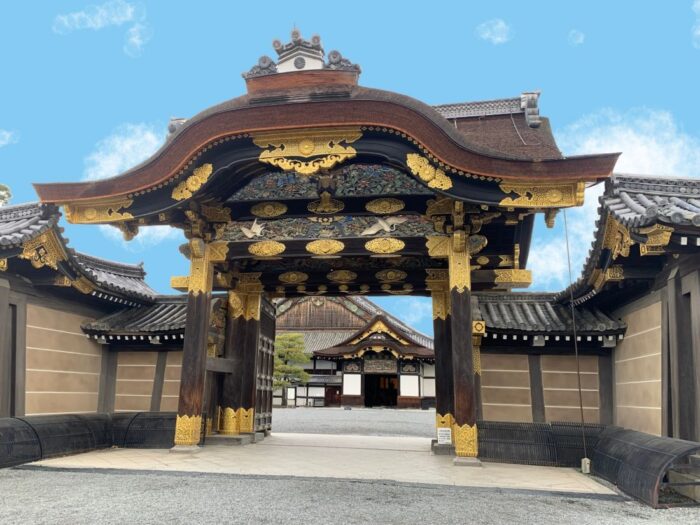In Kyoto, January is a month bursting with traditional customs and cultural events. Visitors flock to shrines like Fushimi Inari Taisha and Jishu Shrine for Hatsumōde, where they pray for good luck and success in the new year.

The Yasaka Shrine Okera Mairi Ceremony lights bonfires to ward off negative energies. Nijo-jo Castle opens its gardens, offering a chance to explore this UNESCO World Heritage Site.
And at Shimogamo Shrine, the Kemari Hajime Festival celebrates ancient games. These January traditions immerse visitors in Kyoto’s rich cultural heritage.
Key Takeaways
- Hatsumōde is a traditional Japanese custom where devotees visit shrines in Kyoto for good luck and success, praying for various aspects of their lives such as career, romance, academic excellence, and health.
- Yasaka Shrine in Kyoto holds the Okera Mairi Ceremony, an annual New Year tradition where bonfires are lit with okera tree roots to cast away negative energies from the previous year and turn the flames into symbols of good luck.
- Nijo-jo Castle opens its gardens to the public in January, providing a unique opportunity to visit the UNESCO World Heritage Site and explore the interconnected buildings of Ninomaru-goten Palace and the relocated Honmaru-goten Palace.
- The Kemari Hajime Festival at Shimogamo Shrine honors the gods and features the traditional Kemari game introduced from China, where participants dressed in court costumes kick a deer skin ball called mari, emphasizing cooperation and skillful play.
Hatsumōde: Traditional Shrine Visits

Visitors to Kyoto in January can participate in the traditional Japanese custom of Hatsumōde. This centuries-old tradition involves visiting shrines for prayers of good luck and success in various aspects of life. It is a way to start the new year on a positive note and seek blessings from the deities.
People flock to popular shrines like Fushimi Inari Taisha and Jishu Shrine to offer their prayers. At the shrines, special rituals and blessings are performed to ensure a prosperous year ahead. Sake is offered to visitors to keep them warm during the cold winter days.
The sale of hamaya, arrow charms, is also a common practice during Hatsumōde. These charms are believed to bring good fortune and are often displayed at home as a symbol of luck.
Kyoto’s famous shrines like Kitano Tenmangū are preferred destinations for Hatsumōde. Visitors can experience the rich cultural heritage of Japan while seeking blessings for the year ahead.
Okera Mairi: Bonfires to Cast Away Negativity
Participants in the Okera Mairi ceremony at Yasaka Shrine in Kyoto cast away negativity from the previous year by lighting bonfires with okera tree roots. This ancient tradition, which takes place from December 31 to January 1, is a powerful way to start the New Year with positive energy.
As the flames dance and crackle, negative energies are symbolically burned away, making room for new beginnings and good fortune. The participants then turn the flames into portable beacons of luck, carrying them home to spread the positive energy throughout their lives.
The ceremony also includes the lighting of toro lanterns, which are lit by the okera root fires, creating a stunning visual spectacle. It’s a truly unique and immersive experience that allows participants to actively participate in the purification and renewal of their own spirits.
Nijo-jo Castle Garden Special Opening

The Nijo-jo Castle gardens offer a unique opportunity for the public to explore and appreciate the beauty of the interconnected buildings and designated UNESCO World Heritage Site.
With its special opening in January, visitors can immerse themselves in the rich history and architectural marvels of this iconic castle in Kyoto.
The gardens provide a tranquil escape from the bustling city, allowing visitors to stroll through meticulously manicured landscapes and take in the serene atmosphere.
From the Ninomaru-goten Palace with its stunning architecture to the relocated Honmaru-goten Palace, there is much to discover and admire.
The Nijo-jo Castle gardens truly transport visitors back in time, providing a glimpse into the grandeur and elegance of Japan’s feudal era.
It is a must-visit destination for history enthusiasts and nature lovers alike.
Kemari Hajime Festival at Shimogamo Shrine
The Kemari Hajime Festival at Shimogamo Shrine showcases the ancient and cooperative game of Kemari. Players kick a deer skin ball called mari while dressed in traditional court costumes.
This festival is held every year on January 4th and is a celebration that honors the gods. It dates back to the Heian period.
The game of Kemari was introduced from China and has no declared winners or losers. Instead, the emphasis is on cooperation and skillful play.
Participants, who come from various backgrounds, kick the mari with precision and grace while donning exquisite court attire. The festival was revived in the early 20th century by the Kemari Preservation Society. This ensures that this traditional game continues to be enjoyed and appreciated by all.
It is a truly captivating sight to witness the players engage in this ancient form of entertainment, bringing history to life before your very eyes.
Other January Events in Kyoto
The Toka Ebisu Festival in the Gion district of Kyoto showcases traditional rituals and performances to celebrate prosperity and good fortune in the new year. This festive event brings together locals and travelers alike to experience the vibrant atmosphere and immerse themselves in the rich culture of Kyoto.
The festival features several highlights that are sure to captivate the audience:
- Rituals and Prayers: Visitors have the opportunity to participate in age-old rituals and offer prayers for blessings and success in various aspects of life, such as career, romance, academic excellence, and health.
- Traditional Performances: The festival showcases captivating performances by geisha and maiko, who grace the stage with their graceful dances and musical performances.
- Market Stalls: The festival is also known for its lively market stalls, where visitors can indulge in delicious street food, buy traditional crafts and souvenirs, and enjoy the lively atmosphere of the festival.
With its vibrant energy, traditional rituals, and lively performances, the Toka Ebisu Festival is a must-visit event for anyone seeking a unique and memorable experience in Kyoto.
Cultural Delights: Geisha Performances and Bonsai Exhibition
After exploring the various events and festivals in Kyoto during January, it’s time to delve into the cultural delights that this vibrant city has to offer.
One of the highlights is the Geisha District Performances at Yasaka Shrine. This mesmerizing event showcases the elegance and grace of Kyoto’s renowned geisha. Visitors can witness traditional dances, music performances, and even interact with the geisha themselves. It’s a rare opportunity to get a glimpse into the captivating world of these skilled entertainers.
Another cultural delight in Kyoto during January is the Gafūten Shōhin Bonsai Exhibition at Miyako Messe. Bonsai, the art of growing miniature trees, is deeply rooted in Japanese culture. This exhibition features stunning displays of meticulously pruned and trained bonsai trees, showcasing the mastery of the artists. Visitors can appreciate the intricate details and sheer beauty of these living works of art.
Both the Geisha District Performances and Bonsai Exhibition offer a unique insight into the rich cultural heritage of Kyoto, making them must-see attractions for anyone visiting the city in January.
Frequently Asked Questions
How Long Has the HatsumōDe Tradition Been Practiced in Japan?
The hatsumōde tradition has been practiced in Japan for centuries. It is a traditional custom for celebrating the New Year, where devotees visit shrines within the first week of January to pray for good luck and success in various aspects of life.
What Is the Significance of Offering Sake to Visitors During HatsumōDe?
Offering sake to visitors during Hatsumōde is a traditional way to provide warmth and hospitality. It adds to the festive atmosphere and symbolizes the wishes for good luck and prosperity in the new year.
Are Hamaya (Arrow Charms) Only Sold During the HatsumōDe Period?
Yes, hamaya (arrow charms) are typically sold during the hatsumōde period. They are believed to bring good luck and fortune for the new year. People often display hamaya at home as symbols of protection and prosperity.
Can You Provide More Information About the Kemari Game and Its Origins?
The kemari game, played with a deer skin ball called mari, dates back to the Heian period and was introduced from China. Its emphasis on cooperation and skillful play makes it a unique and captivating tradition.
Are the Geisha District Performances at Yasaka Shrine Exclusive to the Month of January?
No, the geisha district performances at Yasaka Shrine are not exclusive to the month of January. These captivating performances can be enjoyed throughout the year, offering a glimpse into the enchanting world of geisha culture.
The Sum Up
To sum it up, Kyoto’s January traditions offer a captivating and immersive experience for visitors.
From the serene and powerful Hatsumōde shrine visits to the mesmerizing Okera Mairi bonfires that cast away negativity, there is something for everyone to enjoy.
The Nijo-jo Castle Garden opening provides a unique opportunity to explore a UNESCO World Heritage Site, while the Kemari Hajime Festival showcases ancient games and emphasizes cooperation.
With cultural delights such as geisha performances and a bonsai exhibition, Kyoto in January is a treasure trove of traditions and cultural delights waiting to be discovered.





